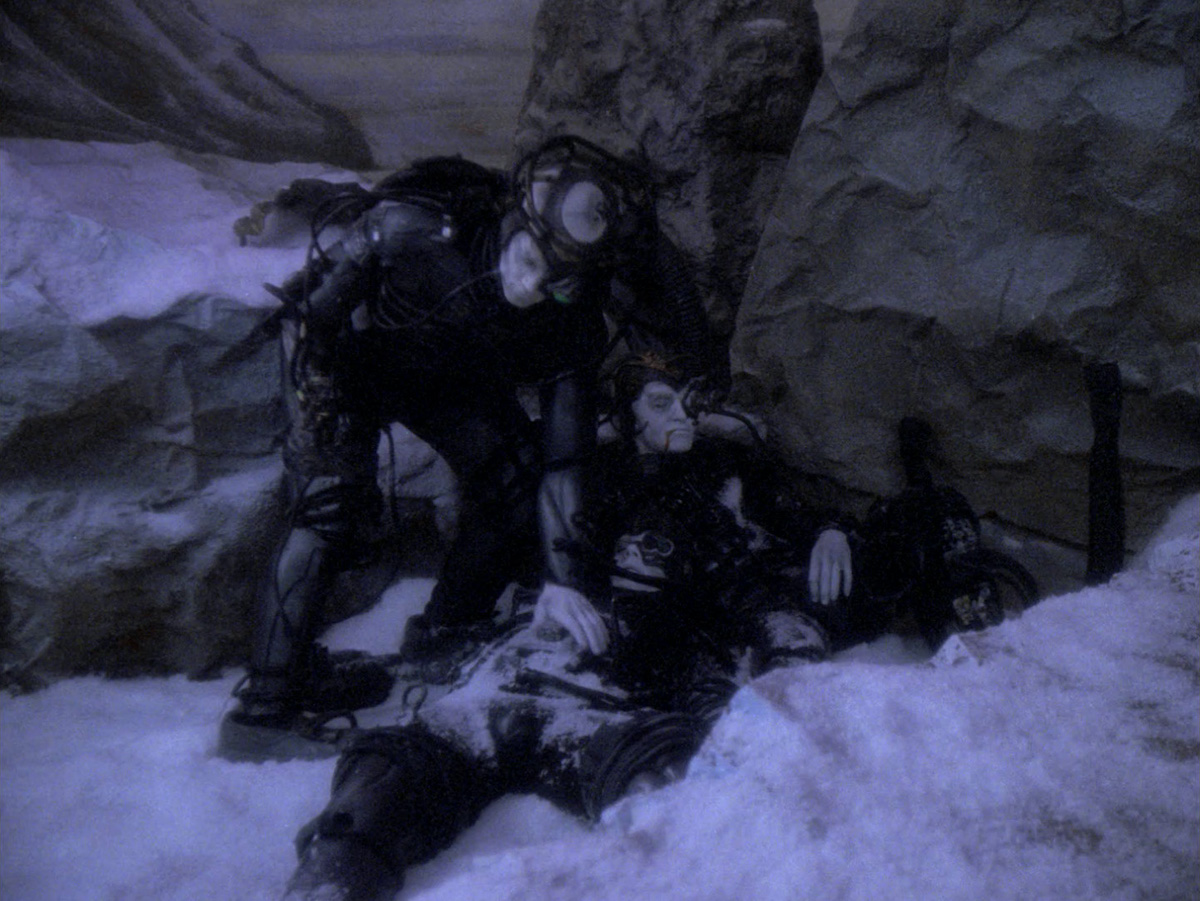“We are Hugh.”
I fucking hate the Hugh the Borg episode. I always have. Everyone else loves it; I absolutely loathe it. As you’ve probably realized by now, a) I was a huge fan of the Borg as they were originally conceived in “Q Who,” and b) I couldn’t stand watching them get thoroughly de-fanged by Star Trek: The Next Generation, Star Trek: First Contact, and Star Trek: Voyager.
Fuck, they were such a good idea at the beginning. But the writers chickened out completely on just letting the Borg be the Borg, preferring instead to simultaneously bring them down to our level (an understandable side-effect of needing, pragmatically, to find a way to defeat them every time they showed up) while upping their “cool” factor as one of Star Trek’s signature villain races. They accomplished the latter by massively expanding (and thereby de-mystifying) the Borg’s entire tech-noir backstory. Nanoprobes, assimilation tubules, the Borg Queen, Unimatrix One… all of this explain-the-Borg claptrap was the Midichlorians before there were Midichlorians. Don’t even get me started on Seven of Nine.
But arguably, Seven of Nine started here, when Star Trek: The Next Generation castrated the whole concept of the Borg by breaking a single drone away from the hive mind and having him become a puppy. That’s basically what Hugh, the emancipated Borg, is: a cute Borg pet for the Enterprise. (How the producers resisted the temptation to actually keep Hugh on the ship as a recurring character is beyond me; but then, by the time we get to Voyager’s phalanx of Borg children, we’ve gone down that road anyway.)
As what is perhaps a logical extension of the Locutus story from “The Best of Both Worlds,” Star Trek becomes hereafter fascinated with the idea of liberating individuals from the Borg collective and having them reassert their pre-assimilation personality. (Or in Hugh’s case, their native personality, because there’s no evidence that Hugh wasn’t just born a Borg.) As a narrative idea, I do not find the notion of liberated Borg interesting in the slightest. Every bit of juice that could be wrung out of that fruit was expended on Picard in “Family,” and everything since then – starting with Hugh – has been trivial, facile, and pointless. It’s a predictably American story theme: the individual is all, and must triumph above the collective will of the community.
“I Borg” is extremely well put together as an episode, which makes it hard for me to sling the zero Enterprises at it that I’d like to administer. There are some great scenes. The real strengths are in performance, particularly from Patrick Stewart and Whoopi Goldberg, whose (appropriately) horrified reactions to the cuddlification of Hugh are the last gasps of the monumental terror that the thought of the Borg once unleashed. (The utter revulsion with which Guinan looks at Hugh is one of her character’s high points.) There’s a great scene of Picard and Guinan fencing (!), which includes an ad hoc tactical lesson from the latter, who uses Picard’s sympathy for her feigned leg cramp to stab him in the heart. (No subtlety there, or ever, from Guinan.) There are also good scenes for Geordi, who initially befriends the young Borg. Because who else would it have been?
But the crux of the episode – that “American” throughline I mentioned above – ultimately hinges upon a basic decision on the part of Star Trek about what the Borg actually are. Up till now, they were locusts. The great Borg stories – “Q Who” and “The Best of Both Worlds” on the series, and Vendetta (and the exception that proves the rule, the clever reverse-engineered origin story in the Destiny trilogy) in the novels – understood that the Borg’s menace as a foe came from their sheer implacability. They weren’t people; they didn’t give a fuck about you; and you couldn’t (in an important reversal for Star Trek) talk your way out of trouble.
But from here, Star Trek being Star Trek, it simply becomes impossible for the series to let go of the idea that within each drone, there’s a frightened little Hugh waiting to come out and play with the proverbial Geordi. It’s part of a terminal strategy to remove the risk and drama from everything in Star Trek, and it succeeds beyond its wildest dreams. Yup, I’m calling it: everything that was dramatically successful and artistically interesting about Star Trek gets shunted off at this point. (It gets shunted to Deep Space Nine, natch.) The mealy-mouthed, forced blandness of the “core” Star Trek canon from here till the reboot – most of the rest of Next Gen, plus Voyager, First Contact, Insurrection, Nemesis and Enterprise – are the reason there had to be a reboot.
And so, the dramatic essence that made “Q Who” so strong – what if the Enterprise came across a foe they just couldn’t handle? – is erased, and never returns; and never really returns to the prime Star Trek franchise, at all. It’s ironic that at the end of “I Borg,” the crew of the Enterprise decide not to send Hugh back into the Collective as a walking bomb, carrying programming that would wipe out the entire Borg race. Metatextually, that’s exactly what happened anyway.

Bad news, blogateers: CBS has pushed the release of Star Trek: The Next Generation Season 6 on blu-ray to June! Consequently, Blogging the Next Generation will go on a brief hiatus after the conclusion of Season 5 at the beginning of April. Meantime, you can pre-order Season 6 here.
Blogging The Next Generation runs every Tuesday as I work my way through the episodes of Star Trek: The Next Generation on blu-ray. Season Five is in stores now.
